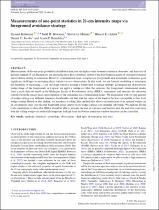| dc.contributor.author | Kittiwisit, Piyanat | |
| dc.contributor.author | Bowman, Judd D. | |
| dc.contributor.author | Murray, Steven G. | |
| dc.date.accessioned | 2023-01-30T12:02:47Z | |
| dc.date.available | 2023-01-30T12:02:47Z | |
| dc.date.issued | 2022 | |
| dc.identifier.citation | Kittiwisit, P. et al. (2022). Measurements of one-point statistics in 21-cm intensity maps via foreground avoidance strategy. Monthly Notices of the Royal Astronomical Society, 517(2), 2138-2150. https://doi.org/10.1093/mnras/stac2826 | en_US |
| dc.identifier.issn | 1365-2966 | |
| dc.identifier.issn | https://doi.org/10.1093/mnras/stac2826 | |
| dc.identifier.uri | http://hdl.handle.net/10566/8319 | |
| dc.description.abstract | Measurements of the one-point probability distribution function and higher-order moments (variance, skewness, and kurtosis) of
the high-redshift 21-cm fluctuations are among the most directstatistical probes of the non-Gaussian nature ofstructure formation
and evolution during re-ionization. However, contamination from astrophysical foregrounds and instrument systematics pose
significant challenges in measuring these statistics in real observations. In this work, we use forward modelling to investigate
the feasibility of measuring 21-cm one-point statistics through a foreground avoidance strategy. Leveraging the characteristic
wedge-shape of the foregrounds in k-space, we apply a wedge-cut filtre that removes the foreground contaminated modes
from a mock data set based on the Hydrogen Epoch of Re-ionization Array (HERA) instrument, and measure the one-point
statistics from the image-space representation of the remaining non-contaminated modes. We experiment with varying degrees
of wedge-cutting over different frequency bandwidths and find that the centre of the band is the least susceptible to bias from
wedge-cutting. Based on this finding, we introduce a rolling filtre method that allows reconstruction of an optimal wedge-cut
21-cm intensity map over the full bandwidth using outputs from wedge-cutting over multiple sub-bands. We perform Monte
Carlo simulations to show that HERA should be able to measure the rise in skewness and kurtosis near the end of re-ionization
with the rolling wedge-cut method if foreground leakage from the Fourier transform window function can be controlled. | en_US |
| dc.language.iso | en | en_US |
| dc.publisher | Oxford University Press | en_US |
| dc.subject | Statistics | en_US |
| dc.subject | Cosmology | en_US |
| dc.subject | Re-ionization | en_US |
| dc.subject | Astronomy | en_US |
| dc.subject | Physics | en_US |
| dc.title | Measurements of one-point statistics in 21-cm intensity maps via foreground avoidance strategy | en_US |
| dc.type | Article | en_US |

